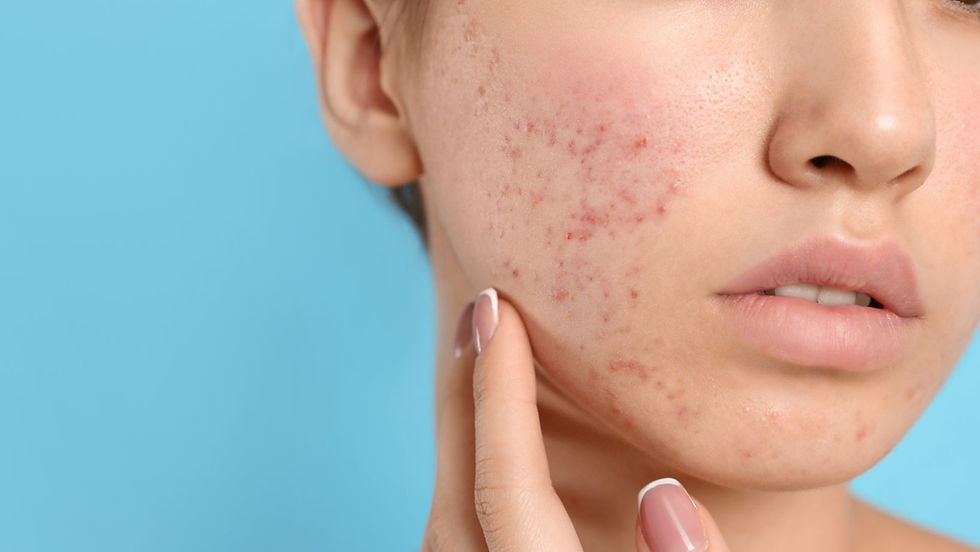Can Facials Help with Acne The Best Treatments for Clear Skin
- Nancie Grace
- Apr 20
- 4 min read
Acne is one of the most common skin concerns in Canada, affecting people of all ages—not just teenagers. Whether you're dealing with hormonal breakouts, stress-induced flare-ups, or persistent adult acne, it’s normal to feel frustrated by the trial-and-error nature of finding something that actually works. Among the many treatments out there, facials are often recommended. But can they really help with acne, or are they just a relaxing treat with little impact?

The truth is, when done properly and paired with the right skincare routine, facials can be a powerful tool in managing and even reducing acne. In this article, we’ll break down how facials can help, which treatments are most effective, and what to look for—especially in the Canadian climate where environmental factors can also play a role in skin health.
What Causes Acne?
Before jumping into how facials can help, it's useful to understand what causes acne in the first place. Acne forms when hair follicles become clogged with oil (sebum), dead skin cells, and sometimes bacteria. This leads to blackheads, whiteheads, pimples, or deeper cystic blemishes.
Several factors contribute to acne:
Hormonal changes, especially during puberty or menstrual cycles
Excess oil production
Bacteria (specifically Propionibacterium acnes)
Stress and diet
Environmental factors, like pollution and dry or humid climates
Can Facials Help with Acne?
The short answer: yes, but not all facials are created equal. A facial that's designed specifically for acne-prone skin can help unclog pores, reduce inflammation, kill acne-causing bacteria, and support your skin’s healing process. But if done incorrectly or too aggressively, it can actually make things worse.
That’s why it’s important to consult with a certified esthetician or dermatologist who understands your skin type and the nature of your acne.
The Best Types of Facials for Acne-Prone Skin
Here are some facial treatments that have shown promising results in treating acne:
1. Deep Cleansing Facial
A deep cleansing facial focuses on removing impurities and decongesting the skin. This typically includes:
Steam to soften pores
Gentle extractions
Exfoliation with acids like salicylic or glycolic
Soothing masks to calm inflammation
This is one of the most common facials for acne and can be done every 4–6 weeks for ongoing maintenance.
2. Chemical Peels
Chemical peels use acids to exfoliate the outer layer of the skin. This can reduce acne and improve skin texture over time. Light peels with salicylic acid are especially effective for acne-prone skin, as they target oil production and unclog pores.
In Canada, chemical peels are typically offered in dermatologist offices and medispas. Make sure the treatment is tailored to your skin type and concerns—some peels are too harsh for sensitive skin.
3. LED Light Therapy
This treatment uses specific wavelengths of light to target bacteria and reduce inflammation:
Blue light: kills acne-causing bacteria
Red light: reduces redness and supports healing
LED facials are non-invasive and safe for most skin types. They’re particularly popular in urban centres across Canada, like Toronto, Vancouver, and Montreal, where clinics often combine them with other acne treatments.
4. Hydrafacial
This is a newer technology that combines cleansing, exfoliation, extraction, hydration, and antioxidant protection. It’s gentle but effective, making it a great option for those with mild to moderate acne who want clearer skin without irritation.
Hydrafacials are gaining popularity in Canadian clinics due to their minimal downtime and instant glow.
What to Avoid in Acne Facials
Not every facial treatment is acne-friendly. Be cautious of:
Overly aggressive exfoliation (like microdermabrasion on active breakouts)
Heavy oils or comedogenic ingredients in masks and moisturizers
Non-certified spas offering unregulated treatments
Also, avoid picking at your skin or scheduling a facial too close to a major event if you’re prone to post-treatment purging or redness.
Supporting Your Facial Results at Home
Facials work best when combined with a solid at-home skincare routine. Here are a few essentials:
Cleanser: A gentle, pH-balanced cleanser to remove dirt and oil
Exfoliator: Use a BHA-based product 2–3 times a week to keep pores clear
Moisturizer: Yes, even acne-prone skin needs hydration—look for lightweight, non-comedogenic options
Sunscreen: Always use SPF during the day, especially after treatments like chemical peels
Conclusion
Facials can absolutely be worth it if you’re dealing with acne—especially when you choose the right type and pair it with consistent skincare. While they’re not a magic fix, they can be a valuable part of a comprehensive acne treatment plan.
When to See a Skincare Professional
If you’ve tried multiple over-the-counter products without success, or if your acne is persistent and affecting your confidence, it may be time to see a certified esthetician. A trained skincare professional can assess your skin, identify the root causes of your breakouts, and create a personalized treatment plan tailored to your needs.
At SkinLAB, our estheticians specialize in acne treatments—including deep cleansing facials, LED therapy, chemical peels, and customized skincare routines designed to support long-term results. Whether you're dealing with active breakouts or post-acne scarring, professional guidance can make a noticeable difference.
In Calgary, accessing expert skincare doesn't require a referral. You can book a consultation directly with SkinLAB and start your journey to clearer, healthier skin right away.


Comments